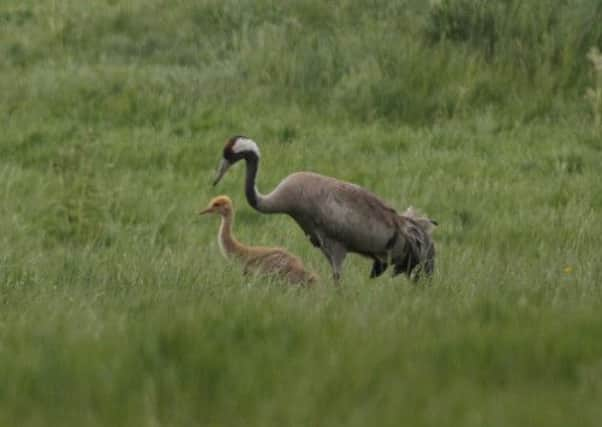First cranes breed in Scotland since Middle Ages


The shy, tall and graceful wetland bird, which is flightless when moulting, is believed to have been hunted to extinction in Scotland 500 years ago.
But, in a remarkable turnaround in its fortunes, the common crane – celebrated for its loud trumpeting calls and elegant breeding displays – has re-established a slender foothold at a secret nesting site in the North-east of Scotland.
Advertisement
Hide AdAdvertisement
Hide AdRSPB Scotland revealed yesterday that the same pair of cranes have successfully raised two chicks – one each breeding season – over the last two years at a carefully guarded wetland site.
And there are hopes that they could be the vanguard of a gradual re-colonisation by the common crane in Scotland as their numbers continue to rise in their breeding heartland on continental Europe.
Small but increasing numbers of the migratory birds, which spend their summers in northern Europe and winters in France and Spain, have already passed through Britain in recent years. And a small breeding population is already becoming established in East Anglia and Yorkshire.
Stuart Housden, the director of RSPB Scotland, said: “We are stunned and delighted to see that common cranes have bred successfully in Scotland.
“These charming, elegant birds have a strong place in our myths and history and are a delight to see, particularly during the breeding season with their ‘dancing’ displays.
“They undertake regular migrations and small numbers have turned up on the east coast of Scotland in recent years, raising hopes of a re-colonisation. Last year the pair reared one chick – followed by a second chick in 2013.
“Thanks to the co-operation of farmers in the area, the conditions appear to be right for cranes to take up residence and it is possible that more will choose to re-establish themselves in the country in future.
“We have been working with local farmers, landowners and the community to monitor these fantastic birds.”
Advertisement
Hide AdAdvertisement
Hide AdKeith Morton, the species policy officer with RSPB Scotland, said: “Looking at that pattern of recovery across Europe, it was fairly obvious to us that, at some point, they were going to come back and try and breed here.
“But we weren’t quite sure if we still had the habitat the birds need because they are big birds and tend to need quite a lot of space and they are very sensitive to disturbance.”
Cranes, he explained, tended to “prospect” sites for a couple of years before settling on a nest site.
But the breeding pair had remained undetected until their secret nesting site was first discovered by RSPB Scotland two years ago.
A RSPB spokeswoman said: “Cranes were once present in Scotland but died out centuries ago, primarily due to hunting and their popularity as a dish at medieval banquets.
“Habitat loss and a slow reproductive cycle may have also led to their disappearance.”
A right royal delicacy at the court of King James
THE only hard evidence of cranes breeding in Scotland comes from bones recovered from an Iron Age site on Orkney by archaeologists.
The birds are believed to have been hunted to extinction in Scotland in the late Middle Ages, although there are contemporary documents around the reign of James V (1512-1542) referring to the Scottish Court feasting on crane at banquets.
Advertisement
Hide AdAdvertisement
Hide AdRe-colonisation of the crane began in Norfolk during the late 1970s. The UK breeding population stood at 17 pairs in 2011. Small numbers pass through Britain in the spring and autumn.
The RSPB’s Loch of Strathbeg nature reserve, a coastal wetland near Fraserburgh, is visited by migrating cranes but is not the location of the nesting site.